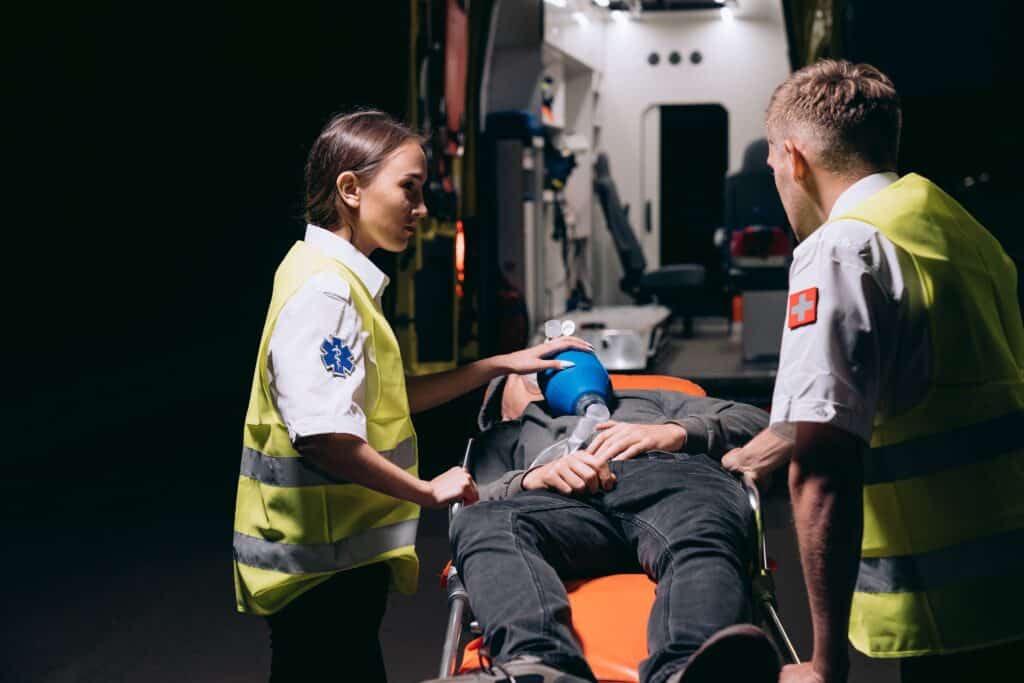EMT Certification – Overview
Emergency medical technicians (EMTs) are clinicians trained to respond quickly to medical emergencies.
These technicians are employed by the government, hospitals, ambulance services, fire departments and police forces. Some EMTs can also be unpaid volunteers.
EMTs are the first responders who are called to a scene of an emergency. This emergency can be a car accident, fire, dog bite or someone critically ill.
EMTs support the injured and ill, administer medications, and provide emergency medical care procedures.
There are different levels of EMT and each requires passing an exam to obtain a certification.
The level of certification determines the scope of practice for EMTs. Each level requires different exams that reflect the specific competencies associated with that level. An EMT certification exam usually includes a cognitive exam and a psycho-motor exam.
The cognitive exam tests your knowledge of trauma, cardiology, resuscitation, ventilation, respiration, airways, EMS operations, medical, obstetrics, and gynecology.
The psycho-motor exam provides a hands-on practical exam to demonstrate your emergency medical skills.
4 Steps to Earn EMT Certification

A high school diploma or GED credential is a necessary basic requirement to become an EMT. Before enrolling in a post-secondary emergency medical technology program, you must also earn CPR certification.
EMT certification programs typically last from a few months to about a year, depending on the level of certification being pursued.
Here is a step-wise process to earn EMT certification in the US:
Step 1 – Complete EMT Basic Training
As an aspiring EMT, you should first earn a CPR certification. You can seek CPR certification from several organizations, such as the American Heart Association or the American Red Cross.
You will also need to complete a post-secondary emergency medical technology program.
You can pursue this program at a university, technical, or community college. It usually takes 1 to 2 years to complete. This certification teaches you to safely evaluate, care for, and transport patients.
Step 2 – Pass the National/State Exam for Certification
To work as an EMT, you will need to earn state certification. Several states require state-specific certification, while most accept certification from the NREMT exam.
To take this exam, you should complete a state-approved training course within the past 2 years of applying.
The NREMT exam consists of a psycho-motor portion and a cognitive test. Candidates are allowed three attempts to pass the cognitive exam. If they fail after three attempts, they must complete additional education before they can test again.
If you fail to pass the exam, you can reapply to take the cognitive exam once more after 15 days of receiving your results.
You can take the psycho-motor portion of the exam using a state-approved training site or a state emergency service.
Step 3 – Complete Advanced EMT Training (optional)
This is optional, but many EMTs prefer completing additional training even after being certified. These advanced courses prepare EMTs for the Advanced EMT exam conducted under the NREMT.
The required hours of fieldwork can vary significantly depending on the program and state requirements, especially for advanced EMT training, which may require more than 200 hours of total training, including both classroom and fieldwork. Many programs require internship clinical rotations in an emergency services agency or a medical emergency room.
Step 4 – Complete a 2-year Degree Program (optional)
Once you have obtained additional EMT training, you can prepare to enroll in a 2-year degree program in emergency care training.
These are usually offered by universities, technical institutes and community colleges through an associate’s degree.
These associate degree programs usually cover advanced life-support techniques, anatomy, physiology, etc.
This step is optional if you want to become a certified EMT, but it can help you earn more and ensure faster promotion at your employment.
What is the EMT Course from Coursera
Coursera offers exclusive EMT courses for aspiring emergency medical technicians in the US.
Course 1 teaches you to assess an emergency scene and make preparations to provide care. This course trains you to understand the structure of patient assessment, the history of emergency medical services and the personal requirements you will need to become a certified EMT.
Course 2 will teach you about airways, breathing, circulation, medications and medication administration that are allowed for EMTs.
This course also teaches you to identify signs and symptoms of stroke, diabetes, cardiac arrest, etc.
Course 3 from Coursera’s EMT program trains you in skills related to toxicology, cardiopulmonary resuscitation, wilderness emergency medicine, high-performance CPR, etc. Course 4 from Coursera offers skills essential for trauma emergencies, while Course 5 teaches about pediatrics, infants, and pregnancy.
What are the salary and career outlook for EMTs
According to reports by the US Bureau of Labor Statistics (BLS), the median annual salary for EMTs in the US is around US$36,680. The highest-earning 10% can earn more than US$62,150 per year.
Regarding career growth prospects, reports from BLS suggest that the employment of EMTs and paramedics is projected to grow 11 percent from 2020 to 2030, faster than the average for all occupations, according to the latest projections from the BLS.
This is faster growth in demand than all other occupations.
Conclusion
Earning an EMT certificate or diploma is only the starting point of education for aspiring medical students.
If you want to further develop your EMT knowledge and skills, you can obtain an associate’s or bachelor’s degree.
See Also
How to Become an Emergency Physician